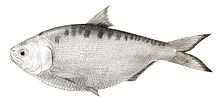
Clupeiformes is the order of ray-finned fish that includes the herring family, Clupeidae, and the anchovy family, Engraulidae. The group includes many of the most important forage and food fish.

Sardinella is a genus of fish in the family Dorosomatidae found in the Atlantic, Indian and Pacific Ocean. They are abundant in warmer waters of the tropical and subtropical oceans. Adults are generally coastal, schooling, marine fish but juveniles are often found in lagoons and estuaries. These species are distinguished by their ranges and by specific body features, but they are often confused with one another. Fish of the genus have seven to 14 striped markings along the scales of the top of the head. The paddle-shaped supramaxilla bones are characteristic; they separate Sardinella from other genera and their shapes help distinguish species. They have paired predorsal scales and enlarged fin rays.

Dorosoma is a genus that contains five species of shads, within the family Dorosomatidae. The five species are native to the North and/or Central America, and are mostly known from fresh water, though some may reside in the waters of estuaries and bays.

Limnothrissa is a small genus of freshwater ray-finned fishes elonging to the family Dorosomatidae, which also includes the gizzard shads and sardinellas. The species in this genus are endemic to Africa. It was considered to be monospecific but L. strappersi, a Lake Mweru endemic, has been recognised as a valid species. The Lake Tanganyika sardine was endemic to Lake Tanganyika but has been introduced to Lake Kivu, Lake Kariba and the Cahora Bassa reservoir.

Tenualosa is a genus of fish in the family Dorosomatidae. When subfamilies are recognized, it is placed in the subfamily Alosinae or Dorosomatinae.

Gudusia chapra, or the Indian river shad, is a species of fish in the family Clupeidae, occurring in rivers of India and Bangladesh draining to the Bay of Bengal, and also reported from Pakistan and Nepal. Outside the rivers it also occurs in ponds, beels, ditches and inundated fields.
Sardinella richardsoni is a species of ray-finned fish in the genus Sardinella from the South China Sea in the northwest Pacific.

Anodontostoma is a small genus of gizzard shads found in the Indo-Pacific region. It currently contains three described species.

Ethmalosa fimbriata, the bonga shad or just bonga, is a shad-like ray-finned fish, belonging to the family Dorosomatidae, formerly considered to be in the family Clupeidae. This species occurs along the coasts and in brackish water of coastal lagoons, rivers and lakes of western Africa from Dakhla in Western Sahara to Lobito in Angola. It is usually around 25 cm long but the maximum length is 45 cm. It is the only member of its genus.

Gonialosa is a genus of gizzard shads that are found in the rivers of South and Southeast Asia. There are currently three described species.

Harengula is a genus of marine ray-finned fishes belonging to the family Dorosomatidae, the gizzard shads and sarinellas/ The fishes in this genus occur mostly in the western Atlantic, Gulf of Mexico and the Caribbean Sea, with one species in the eastern Pacific Ocean. There are currently four described species.

Lile, the piquitingas, is a genus of small fish belonging to the family Dorosomatidae, which includes the gizzard shads and sardinellas. They are endemic to the Americas. There are currently four recognized species in the genus.

Microthrissa is a genus of freshwater ray-finned fishes belonging to the family Dorosomatidae, which also includes the gizzard shads and sardinellas. The species in this genus are endemic to Africa.
Nannothrissa is a genus of very small fish in the herring family, Dorosomatidae, endemic to the Congo River system in Africa. There are currently only two recognized species

Nematalosa is a genus of gizzard shads in the fish family Dorosomatidae. There are currently 11 recognized species. They are mainly found in Indo-Pacific.

Odaxothrissa, the fangtooth pellonulines, is a genus of fresh-water fish in the family Dorosomatidae. There are currently three recognized species in this genus, all of which are found in tropical Africa.
Platanichthys platana, the Rio Plata sprat, is a very small species of fish belonging to the family, Dorosomatidae. It is endemic to South America. It is the only species in its genus.

The Alosidae, or the shads, are a family of clupeiform fishes. The family currently comprises four genera worldwide, and about 32 species.

Gudusa variegata, the Burmes river shad or variegated herring, is a species of freshwater ray-finned fish belonging to the family Dorosomatidae, the gizzard shads and sardinellas. This species has been only been confirmed to occur in Myanmar in the Irrawaddy River, the Chindwin River and Lake Indawgyi.

Harenngula clupeola, the false herring, false pilchard or red-ear pilchard, is a species of marine ray-finned fish belonging to the family Dorosomatidae, the gizzard shads and sardinellas. The false herring is found in the Western Atlantic Ocean from eastern Florida and the Bahamas through the Gulf of Mexico south to Santa Catarina in Brazil.

















